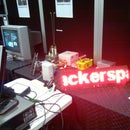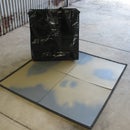Introduction: Sharpening Jig for Turning Chisels
For my birthday I got a wood lathe and some turning chisels so I could do some pen turning. Problem was I had to sharpen the chisels. I already had a cheap grinder on a stand, so I tried to sharpen them freehand with very inconsistent (usually bad) results.
There are a few jigs that you can attach to your grinder that produce consistent and perfectly sharpened chisels. Most are made in the US at a reasonable price but the frieght costs to Australia are huge. The few jigs sold in Australia are over $100 and range towards the $200 mark.
The design I came up with is very similar to the Oneway Wolverine jig. Many turners have made wooden versions of this jig but I decided to make a steel version. It cost me around $50 to make.
Step 1: Design
Getting as much information on commercial sharpening jigs as I could I started the design. It was a very simple design.
Some 30mm square tubing would be attached to the board/stand the router was mounted on. A 25mm square tube would slide trough the 30 mm tube. A threaded knob would then lock the 25mm tube in place. Since I wanted to change the end pieces of the jig a similar system was devised. Initially the locking knob was to be on the side but I wasn't sure and so the final product had 3 different positions for the knob.
I was worried about too much movement of the 25mm tube inside the 30mm tube. Ringing a steel supplier I found out that the 30mm tube comes with a wall thickness of 2mm that leaves a 26mm internal size. Only 1/2 mm gap all around, that's a resonably close fit. Also since the sqaure tubes have a weld on one wall and may not be perfectly square you can get a fairly tight fit.
The whole design uses only 30mm square tube, 30mm angle, and 25mm square tube.
Step 2: Bits and Pieces
Shopping List -
600 mm of 25mm square steel tube
>500 mm of 30mm x 2mm square steel tube - needs to be cut into 2 x 200mm , 2 x 50mm.
>600 mm of 30mm steel angle - needs to be cut into 4 x 30mm, 4 x 45mm, 1 x 230mm.
You can either have the supplier cut the steel or do it yourself. If you do it yourself allow some extra length for the 30mm square and angle due to the cutting blade thickness. Also after cutting you might want to file all the sharp edges.
5/16" nuts - at least 4 for the jig. I bought a box as I can see me using them for more jigs and projects.
4 off 1" knob with 5/16" thread
5/16" Tee nuts - optional, for mounting the jig on a wooden base board
5/16" bolts - optional, for mounting the jig on a wooden base board
Step 3: Support Tubes
Once you have cut all the pieces you will need to drill holes in the 30mm tubes. The 5/16" nuts will be welded over the holes.
The long tubes should have 2 holes drilled in the top. Each is 25mm from the end of the tube. This way you can mount the tube either way around, either side of the grinder. I drilled the holes the next size or 2 up from 5/16" so the screws had some room and the there is some room for error in welding the nuts.
You'll notice in the picture that I drilled a hole in the center of the side. This is because I wasn't sure were the locking knob would work best. In my case the knob worked best on top at the font. You'll also notice that one tube is shorter than the other. When I bought the tubing I miss-calculated the length I needed and ended up with a shorter tube. The length is not critical, so long it is long enough to stop the 25mm tube from wobbling too much.
The markings on the side mark where the angle brackets will be welded, the letters+number correspond a particular angle bracket. The edge of the angle brackets are also 25mm from the edge.
You also need to drill a hole in each of the angle brackets. The angles will become the mounting brackets for the support tubes, the holes are for a screw or bolt to hold the tube to the base. In my case I used 5/16" bolts that screwed into T-nuts under the MDF base.
Step 4: Tool Rests
Now to setup the tool rests. Working from the top down, first we prepare the angles that will hold the tool. One edge of the angle must be flat and square to the sides. If the cuts were not completely square or flat, mine weren't, then you will need to file them until they are. You can see the 3 angles that I filed flat and square, the arrows point to that edge. That edge will be the bottom.
The bases for the tool rests are again 30mm angle. The gouge base is marked down the centre and then a prependicular line 21mm from the back is marked. The point of the holding angles lines up with the back of the base and the centre line. You can the adjust the position of the far edges should line up on the 21mm line (if the are a little long or short, just make the difference equal on both sides).
Same for the skew base centre. The outer markings are 3.5" (89mm) either side of the centre.
Note: since I didn't have any metal blue I used a sharpie instead. The scriber marks are clear enough, though the photos may not show it.
You will also have to file the back corner of the 30mm tubes as the inside of base angles is curved and not a 90 deg. angle. Filing accomodates the curve and allows the base to sit flush with the back of the tube and make welding easier. I also marked a centre line along the top so the base can be lined up.
The rest of the pictures show how the pieces fit together.
Step 5: Welding
Next is to weld the peices together. Try to keep them in line and square to each other. With the tool rests the welds should be behind the vertical tool holding angles. The base angles should be welded along the under side where they touch the tubes.
The nuts just need to be tacked onto the tubes. Try and keep them centred, otherwise the thread of the locking knobs will scrape against the side of the hole. There is a cure if this does happen, use a 5/16" tap which will cut a thread into the side of the hole.
The pictures show the welded jigs.
Thanks to my Uncle Peter who welded the bits for me. He did a great job.
Step 6: Painting
I cleaned up the welds with a file and wire wheel. Then I painted the parts with some hammer tone spray paint in Apple Green. I picked the green as it would match the colour of the grinder. I just hung the parts on the empty clothes line with some long bits of wire hooked through the 30mm tubes and the bolt holes and sprayed away.
After the paint had dried, I ran the 5/16" tap through all the nuts and holes to clear the paint and welding debris from the threads. It also tapped a thread in the side of the hole if the nuts were welded off centre.
Step 7: Mounting
I measured up and cut out a base from some 12mm (1/2") MDF. I then drilled some holes to mount the grinder in the centre of the MDF base. I also made some 40mm spacers from 40mm box section for the grinder. I needed the spacers to raise the centre of the grinding wheels to that of an 8" grinder. This one's only a 6" grinder. Otherwise the jigs would not fit under the grinding wheels.
The centre line of the support tubes need to be in line with the centre of the grinding wheels. After marking the mounting holes for the support tubes, I drilled some 3/8" holes, and hammered in some 5/16" T-nuts on the under side of the MDF base. I then varnished the MDF to seal it from moisture, grease and oil.
The bolts that hold the grinder on the spacers and base also hold it all to the stand. The support tubes were mounted with the bolts and embedded T-nuts.
If you don't have a grinder stand, you could just mount the grinder using T-nuts and put some rubber feet on the base board. You can then clamp the base board to a bench when you need it. You can also mount everything straight onto a bench permanently without the base board.
One slight glitch was that when I mounted the support tubes the bottom of the tubes did not sit flush to the MDF base. It seems the angles did not weld straight and flush with the bottom of the tubes. It seems that the sides of the 30mm square tube are not perfectly flat but slightly curved. So when the angles are welded to the sides of the tube they angle up ever so slightly. I fixed this by shimming the outer side of the angles with some plastic from a margarine container lid (double thickness). This was enough to make the support tube sit flush with the base board.
I won't go into how to use the jigs as there are many instructions on youtube and other sites. Try the Onestep website
http://www.oneway.ca/sharpening/grind_jig.htm. For information on setup and using the jig checkout the Instruction Manual.
They also have some great instructional videos http://www.oneway.ca/multi-media/wolverine_videos.htm .
Step 8: Future Additions
I've been using the jig for several months now and it works very well. You still have to be careful of the final shape of the chisel but it is easier than doing it free hand. Sharpening the skew is a little harder but the jig helps a lot. At least the angles at the cutting edge of the chisels are consistent and correct.
I would like to make a grinding table for use on the other side of the grinder and doing scrapers and parting tools. I have most of the design but haven't finalised it yet.
I also want to make a wheel dressing jig. I have the diamond dresser and at the moment dress the wheel by hand.

Participated in the
Metal Challenge













